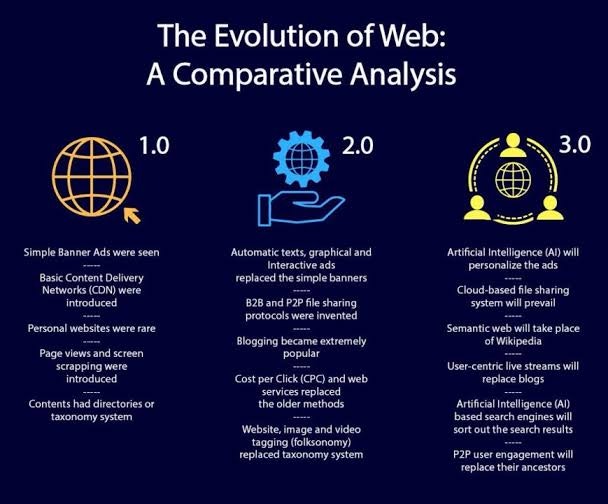What is Web 3.0?
28/04/2022

In Web 1.0, the World Wide Web was just starting to take off and become the phenomenon that we know today. It was mainly used for sharing information between people.
With the advent of Web 2.0, websites started becoming more interactive with users by allowing them to add content and create social media platforms.
But what’s coming in Web 3.0? Some say it’s the internet of things, others say it’s blockchain technology, but nobody really knows for sure!
What is definitely known is that this next iteration of the web will be more decentralized and user-friendly than ever before.
What is Web 3.0 and what are its key features?

Web 3.0 is a term that has been used to describe the next generation of web technologies, which are focused on improving user interactions with web applications and services through the use of decentralized technologies like blockchains, smart contracts, and more.
Some of the key features of Web 3.0 include increased privacy and security, greater trust between users and service providers, and the ability to provide users with more control over their data and interactions.
As these technologies continue to develop, we can expect to see a significant shift in how individuals and organizations interact online as they begin to adopt Web 3.0 capabilities into their web applications and services.
One of the key features of Web 3.0 is its focus on decentralization. This means that instead of relying on a single centralized entity to manage and control the data and interactions within a web application or service, these tasks are distributed among a network of computers.
Another key feature of Web 3.0 is its use of blockchain technology. Blockchain is a distributed database that allows for secure, transparent, and tamper-proof transactions. This makes it ideal for use in a variety of applications, including smart contracts and digital currencies such as Bitcoin.
In addition to blockchain, Web 3.0 also uses other decentralized technologies like peer-to-peer networking protocols, distributed storage networks, and more.
Overall, the adoption of Web 3.0 is still in its early stages, but we can expect to see a significant shift in the way individuals, organizations, and even governments use the web in coming years as these technologies continue to develop and become more widely adopted.
With its focus on decentralization, privacy and security, trust, and user control over their data and interactions, Web 3.0 presents an exciting new direction for the internet.
In order to fully realize its potential, however, we will need to continue developing and improving these technologies as well as integrating them into existing applications and services. Doing so will lead to the widespread adoption of Web 3.0 capabilities.
How will Web 3.0 change the way we use the internet?

With Web 3.0, users will be able to interact with each other and with internet-connected devices in a more natural way. This will be made possible by advances in artificial intelligence (AI) and machine learning, which will allow Web 3.0 applications to understand our needs and preferences better than ever before.
For example, Web 3.0 applications will be able to anticipate our needs and make suggestions or predictions based on the information they have about us and our surroundings, allowing us to more seamlessly interact with others online and conduct everyday tasks like shopping or booking travel faster than ever before.
However, these changes also raise concerns about privacy, data security, and digital disinformation. These issues will need to be addressed by policymakers in order for Web 3.0 to live up to its promise.
What challenges must be overcome before Web 3.0 can be fully realized?
One of the biggest challenges that must be overcome before Web 3.0 can become a reality is the development of a robust and scalable infrastructure. This includes not only improvements to the internet itself, but also the creation of new protocols and standards that will allow for more complex interactions between different users and devices.
Additionally, security concerns must be addressed to ensure that user data is protected from hackers and other malicious actors.
There are also significant challenges related to governance and regulation. For example, some experts have raised concerns over how centralization could impact user privacy, particularly given recent revelations about how companies like Facebook collect and use our personal information without our knowledge or consent.
Ultimately, we will need to focus on developing solutions that strike a balance between openness and security in order to fully realize the potential of Web 3.0.
So, while there are certainly a number of challenges that must be overcome before Web 3.0 can become a reality, I am confident that with continued innovation and collaboration, we will ultimately be able to achieve this important goal.
How can businesses prepare for the arrival of Web 3.0?
Web 3.0 represents a major shift in how businesses operate and interact with their customers online. With the rise of new technologies such as blockchain, artificial intelligence (AI), and virtual reality (VR), it is crucial for businesses to prepare for these changes so that they can continue to be competitive in the market and stay relevant.
One of the first things that businesses need to do to prepare for Web 3.0 is to adopt new technological capabilities as soon as possible. For example, implementing blockchain technology into their business processes can help them become more efficient and secure, while also providing their customers with a sense of trust in the company.
Additionally, businesses should consider using artificial intelligence (AI) to streamline tasks that are often tedious and time-consuming, such as data entry or customer support.
In addition to adopting new technology, it is also important for businesses to take a close look at their website design and content strategy to ensure that they are giving the right impression online.
This may mean revamping their website’s design so that it is clean, modern, and responsive on mobile devices – as most users access websites from smartphones and tablets these days.
It may also involve rethinking content strategy by producing high-quality, engaging, and keyword-optimized content that will attract organic traffic from search engines.
Finally, businesses need to focus on developing strong online branding strategies in order to stand out from the competition. This can be done by creating a unique and recognizable brand identity, using social media platforms to build relationships with customers and followers, and generating positive customer reviews and testimonials.
By taking these steps, businesses will be well-positioned to succeed in the brave new world of Web 3.0.
Final Thoughts
So, what is Web 3.0? In a nutshell, it can be described as the next evolution of the internet. It’s an umbrella term for a range of new technologies and applications currently in development, including blockchain technology, artificial intelligence, and virtual reality.
These advancements have the potential to change the way we interact with the digital world, making it more immersive, user-friendly, and secure. If you want to stay ahead of the curve in today’s tech-driven marketplace, it’s important to understand what Web 3.0 has to offer.
Chat with the expert NFT promoters and marketers at Mooning
Sure, all the examples of NFT promotions we listed are from global brands with endless coin to throw at their campaigns. But you really don’t need a crazy-high budget to see some seriously incredible outcomes – as long as you know the delicate intricacies of building a killer NFT marketing strategy!
If not, no worries – Mooning is here to take care of everything for you and make sure you see the most amazing ROI you’ve ever seen before. Our team has the knowledge and experience to promote your NFTs in order to deliver maximum awareness and interest, driving the sales prices up sky-high and beyond.
We provide a full suite of expert NFT marketing services and go above and beyond for every one of our clients to ensure only the best results. Our team will help with everything from minting, listing and selling, NFT creator sourcing, community management and campaign conceptualisation.
So get in touch with us now on 1300 818 435 or message us online.





